Ⅰ.Introduction
At the General Debate of the 75th Session of The United Nations General Assembly held on September 22, 2020, Chinese President Xi Jinping declared: "We aim to have CO2 emissions peak before 2030 and to achieve carbon neutrality before 2060 (Note 1). The expression of a strong resolve to achieve decarbonization by China, the largest CO2-emitting country in the world, represented a step forward in international cooperation over the fight against global warming.
To achieve carbon neutrality, China, while using new technologies, must act quickly to shift away from the energy structure that is dependent mainly on coal and other fossil fuels and the industrial structure that is skewed toward heavy industries. Doing so is expected to promote innovation and investment in various fields.
Ⅱ.International Cooperation to Curb Global Warming through Decarbonization
Since the Industrial Revolution, global warming has progressed mainly because of a rapid increase in CO2 emissions. The impact of global warming has not only affected climate and ecosystems but is also threatening to reach various aspects of humans' social and economic lives. The Fifth Assessment Report by the Intergovernmental Panel on Climate Change (IPCC) cited the following risks as those that threaten mankind's prosperity and survival if temperature levels continue to rise at the current pace (Note 2).
- (i) Increased sea levels and storm surge damage along the coasts
- (ii) Flood damage to large cities
- (iii) Infrastructure failure due to extreme weather events
- (iv) Death and illness from heat waves, especially in vulnerable urban areas
- (v) Food security threatened by rising temperatures and drought
- (vi) Livelihood and income loss in rural areas due to lack of water resources and reduced agricultural production
- (vii) Loss of marine and coastal water ecosystems and diversity and the assets, functions and services of the ecosystems that are important for livelihoods
- (viii) Loss of terrestrial and inland water ecosystems and diversity and the assets, functions and services of the ecosystems that are important for livelihoods
Governments around the world have reached the consensus that dealing properly with the abovementioned problems by arresting global warming is a precondition for realizing the sustainable development of the world.
The Paris Agreement, which serves as an international framework regarding climate change in the period starting from 2020 was reached at COP21, held in Paris in 2015. It (i) calls for keeping the rise in the average global temperature well below 2 degrees Celsius while continuing efforts to limit the rise to 1.5 degrees Celsius compared with pre-industrial levels and (2) aims to achieve carbon neutrality, which means net zero carbon emissions, in order to hold down temperature rises by ensuring that greenhouse gas emissions from human activities are offset by the combined effects of carbon absorption by forests and other natural carbon sinks, and carbon capture using negative emission technology. In accordance with the agreement, many countries, including Japan, the United States and Europe, have announced policies for achieving carbon neutrality, mostly by 2050. China is also trying to fulfill its responsibilities as the largest emitting country by committing itself to the twin goals of CO2 emission peaking and carbon neutrality (Table 1).
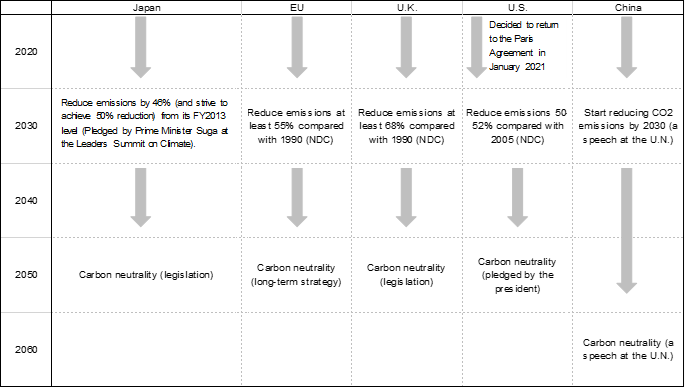
Ⅲ.Gradual Strengthening of China's Commitment to the Fight against Global Warming
China has demonstrated to the international community its deepening commitment to the fight against global warming while increasing its CO2 emissions during the process of developing into an economic superpower.
Under the Kyoto Protocol, which was adopted at COP3, held in Kyoto in November 1997, China was designated as a non-Annex I country (developing country) and was exempted from the obligation to reduce greenhouse gas emissions. However, in November 2009, just before COP 15, held in Copenhagen, the Chinese government announced the goal of reducing the CO2 intensity of GDP (CO2 emissions divided by GDP) by 40-45% by 2020 compared with 2005. This was the first numerical target for emission reduction to be announced by China. Subsequently, in 2015, as its commitment to the Nationally Determined Contribution (NDC) under the Paris Agreement, the Chinese government announced the following goals: (i) ensuring that CO2 emissions will peak by around 2030 and making the greatest possible efforts to bring forward the peak; (ii) reducing the CO2 intensity of GDP by 60-65% by 2030 compared with 2005; (iii) increasing the share of non-fossil energy in the consumption of primary energy to around 20%; and (iv) increasing the forest stock volume by around 4.5 billion cubic meters compared with 2005.
In 2020, President Xi, in a video speech at a U.N. General Assembly session on September 22, announced a new policy of achieving carbon neutrality by 2060 in addition to having CO2 emissions peak by 2030, which is a goal for the NDC under the Paris Agreement. In a video speech at the Climate Ambition Summit on December 12, co-hosted by the United Nations and others, he announced the updated versions of the numerical targets for 2030, other than the target for the peaking of CO2 emissions, as follows: (i) reducing the CO2 intensity of GDP by more than 65% compared to 2005; (ii) increasing the share of non-fossil energy in the consumption of primary energy to around 25%; (3) increasing the forest stock volume by around 6.0 billion cubic meters compared with 2005; and (iv) expanding the capacities of wind and photovoltaic power generation facilities to more than 1.2 billion kW.
The deepening of China's commitment to the fight against global warming is expected to promote domestic structural reforms by inviting increased pressure from the outside and also to encourage international cooperation in combating global warming.
Ⅳ.CO2 Emissions in China
In China, since the launch of the reform and opening-up initiative, energy consumption and CO2 emissions have increased steeply against the backdrop of rapid economic growth (Tables 2 and 3). From 1980 through 2020, China's energy consumption increased 8.3-fold, with the Chinese share in global energy consumption rising from 6.3% to 26.1%. Consequently, China's CO2 emissions grew 6.7-fold, with the Chinese share in global emissions jumping from 7.9% to 30.7%. China is not only the largest energy consumer but also the largest CO2 emitter in the world, and both its energy consumption and CO2 emissions are much larger than the consumption or emissions of the second-largest culprit—the United States in terms of both energy consumption and CO2 emission (in 2020, the United States had a share of 15.8% in global energy consumption and a share of 13.8% in global CO2 emissions).
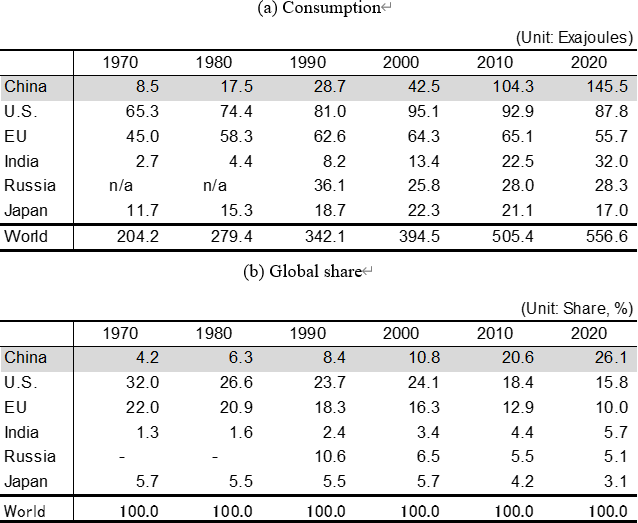
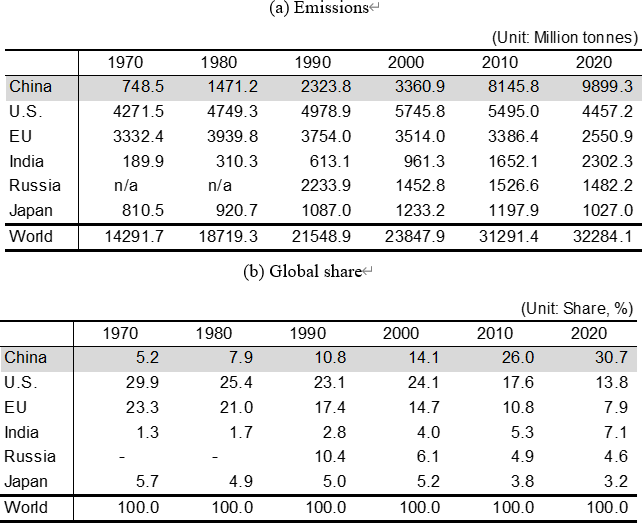
CO2 emissions can be expressed as the product obtained by multiplying (i) GDP, (ii) energy intensity of GDP (energy consumption divided by GDP), and (iii) CO2 intensity of energy (CO2 emissions divided by energy consumption), as indicated by the following mathematical identity that was devised by Professor Emeritus Yoichi Kaya of the University of Tokyo (Kaya identity) (Note 3).

China's large CO2 emissions reflect the expansion of (i) GDP size and the high levels of (ii) energy intensity of GDP and (iii) CO2 intensity of the energy in the country.
Both the energy intensity of GDP and CO2 intensity of energy in China are much higher than the global averages. In 2020, China's GDP accounted for 17.4% of global GDP. If calculated on the basis of this figure, the energy intensity of GDP in China is 50% higher than the global average (26.1% versus 17.4%), while the CO2 intensity of energy is 18% higher than the global average (30.7% versus 26.1%). The CO2 intensity of GDP—which reflects both of those intensities in China—is 76% higher than the global average (30.7% versus 17.4%).
The greatest cause of the high CO2 intensity of energy, and, by extension, of the high CO2 intensity of GDP, in China, is the fact that coal, whose CO2 emissions per thermal unit is high, is the main source of primary energy in the country (Note 4). In 2020, coal accounted for 56.6% of the total primary energy consumption in China, and this figure was much higher than not only coal's shares in the United States (10.5%) and the EU (10.6%) but also its global share (27.2%) (Table 4) (Note 5).
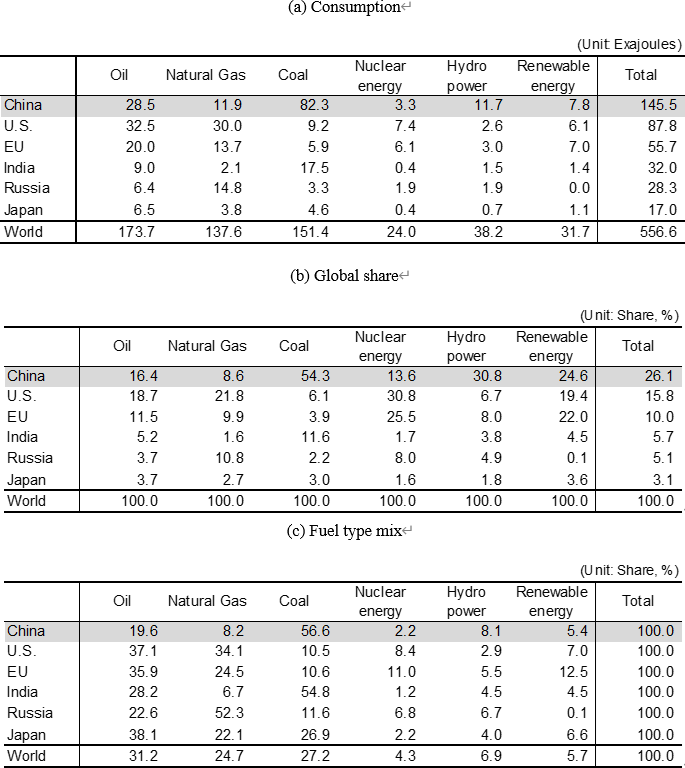
The largest CO2 emission sources in China are energy-intensive industry sectors, including power generation, manufacturing, and transportation. In 2018, the sector-by-sector share of China's total CO2 emissions was 46.9% for power generation, 35.6% for manufacturing and 7.7% for transportation. In the manufacturing sector, heavy industries were the main emission sources, with steelmaking in particular accounting for around half of the emissions from those industries (Note 6).
Ⅴ.How to Achieve Carbon Neutrality
Carbon neutrality could be achieved mainly through the reduction of CO2 emissions. However, as it is realistically difficult to reduce emissions entirely to zero in some fields, it is necessary to offset the remaining emissions with CO2 absorption or capture from the atmosphere (Figure 1).
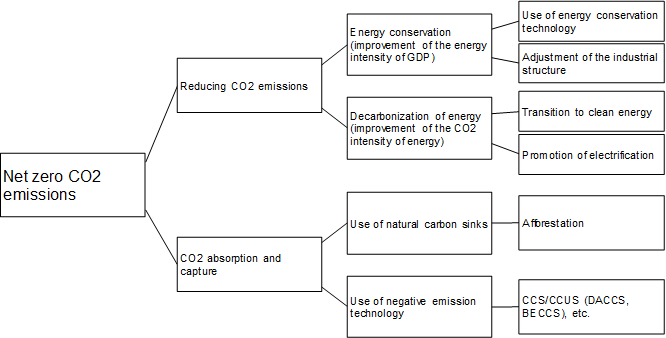
According to the abovementioned Kaya identity, in order to reduce CO2 emissions, it is necessary to curb the energy intensity of GDP and the CO2 intensity of energy if the option of sacrificing GDP expansion due to economic growth is excluded.
To reduce the energy intensity of GDP, it is necessary to take advantage of new technologies for energy conservation in individual fields and increase investments in facilities incorporating those technologies. Meanwhile, in order to improve power transmission efficiency, it is necessary to accelerate the pace of developing an ultra-high-voltage power transmission network and a smart grid (a power transmission network capable of controlling and optimizing the flow of electricity on both the supply and demand sides). Moreover, it is essential to adjust the industrial structure by developing digital, high-tech and modern services industries while restraining the expansion of energy-intensive industries, such as coal-fired power generation, steel, cement, petrochemicals, and chemicals.
Next, in order to reduce the CO2 intensity of energy, it is necessary to shift emphasis in energy consumption from coal and other fossil fuels to clean energy, including photovoltaic, wind, hydro, geothermal and biomass power. In addition, it is essential to achieve decarbonization in terms of final energy consumption through transition from direct combustion to electricity in fields where direct combustion is the mainstay, including hot water supply, room heating and automobiles. In particular, a shift from conventional gasoline- and diesel-powered vehicles to electric vehicles (EVs) is urgently necessary.
On the other hand, regarding CO2 absorption and capture, one option is to increase natural carbon sinks through LULUCF (land use, land use change and forestry) activities. Another option is to use negative emission technologies, including CCS (carbon dioxide capture and storage) and CCUS (carbon dioxide capture and utilization or storage) (Note 7). In particular, there are high expectations for DACCS (direct air capture with carbon storage) and BECCS (bioenergy with carbon dioxide capture and storage).
At the ninth meeting of the Central Financial and Economic Affairs Commission on March 15, 2021, with a view to achieving the CO2 emission peak and carbon neutrality, the commission presented the challenges that should be addressed in the following seven areas in line with the abovementioned principles: (i) energy systems, (ii) major industries, (iii) green and low-carbon technologies, (iv) green and low-carbon policies and market systems, (v) lifestyles, (vi) carbon sinks and (vii) international cooperation (Table 5).
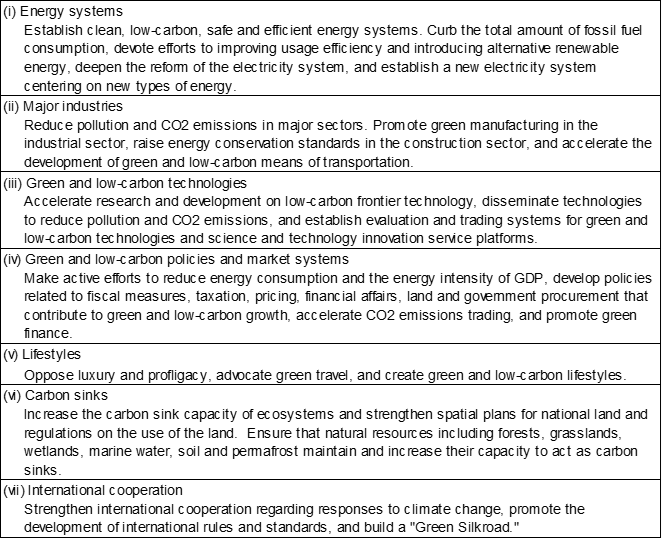
Ⅵ.Opportunities and Challenges for Carbon Neutrality
Making active efforts toward decarbonization with a view to achieving carbon neutrality by 2060 is about to bring many opportunities and challenges to China.
As for opportunities, decarbonization will act as a catalyst for innovation and create investment demand not just in the energy field but across all industries. Governor Yi Gang of the People's Bank of China (PBC) forecast that the value of annual investments necessary for reducing CO2 emissions in China will be 2.2 trillion yuan in the 2020s and 3.9 trillion yuan in 2030 through 2060 (Note 8).
Most carbon neutrality initiatives will also help to rectify China's air pollution problem, which is getting worse. Air pollutants such as sulfur oxides (Sox), nitrogen oxides (NOx) and particulate matter (PM) are derived from fossil fuel combustion, just as CO2 is, and therefore, suppressing fossil fuel consumption with the aim of reducing CO2 emissions contributes not only to the fight against climate change but also to the mitigation of air pollution.
Furthermore, energy security will be enhanced through the replacement of oil and natural gas, for which China's supply depends heavily on imports, with domestically produced clean energy.
On the other hand, as for challenges, China must drastically improve the energy intensity of GDP and the CO2 intensity of energy in order to reduce CO2 emissions because, as a developing country, its economic growth rate is higher than that of developed countries (see the Kaya identity above).
In addition, China's industrial structure is energy-intensive and is skewed toward heavy industries with massive CO2 emissions, and its energy structure is excessively dependent on coal, a highly carbon-intensive fuel. As a result, in order to achieve carbon neutrality, China must drastically change its energy and industrial structures at the same time. During that process, bankruptcies and job cuts will be inevitable in declining industries.
Furthermore, in China's case, the planned period from the CO2 emission peak to carbon neutrality is shorter than the periods in developed countries. For example, the planned period from the CO2 emission peak to carbon neutrality is 71 years for the EU (from 1979 to 2050), 43 years for the United States (from 2007 to 2050) and 42 years for Japan (from 2008 to 2050), while it is only 30 years for China (from 2030 to 2060) (Note 9).
Finally, realizing carbon neutrality requires massive amounts of funds. A CO2 emissions trading system and green finance will play a large role in securing the necessary funds. By taking advantage of the market mechanism, these measures are expected to improve investment efficiency as well.
The original text in Japanese was posted on August 13, 2021.


